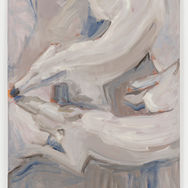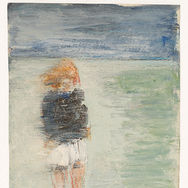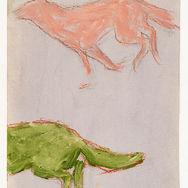LAURA MANINO
Using a pseudoscientific methodology, the artist seeks to discover the territory of which, as an artist, she is a part, by personal choice. Explore, walk and observe. Analyze the areas of accumulation of materials, the frequency of the finds, the influence of the weather or the tide. Collect manually and investigate the origin of the materiality found, with scientific advice. It carries out the collection of these structures on the beaches of Formentera with the authorization of the Ministry of the Environment of the Balearic Government.
In this work, the massive presence on the beaches of the remains of an animal species, belonging to the Porifera class of the Spongiide family, called common marine sponge, is questioned. These remains are a specificity of the territory. What were the conditions that occurred for the arrival of the sponges on the beach? What processes and metamorphoses did they go through? Imagine their history and journey until their fortuitous meeting. In the methodology of his work, he incorporates painting to explore the physical capabilities of the collected skeletons of marine sponges. From the absorption property of the material, observe the changes in texture, volume, weight, and flexibility.
Measure and weigh the marine sponge on a precision scale, before and after immersing it entirely in water pigments.
Record the physical changes produced and then pour the material absorbed by the sponge onto the support. Seek to get as many results as possible. Paint pools, settles, cracks, blends, or blends. traces remain
of the porosity and natural irregularity of the sponges. The experimental result, despite its methodical nature, is strange and accidental. With this working method, he seeks to create a possible emotional understanding of the landscape.

If Mercedes Larreta’s genealogy as an artist were to be written according to the model Marcus Aurelius provides in Book I of his Meditations, it might begin with a strict chronology of her teachers and what she got from each one of them: from Eduardo Audivert (1990), the magic of watercolor and acceptance of the independent will of the drop and its pigment; from Guillermo Roux (2005), the soft fate of oil paint; from Norberto Marcet (2009), representation of the human figure and the reflex to capture the fleeting in its fleetingness; from Lima-native Eulogio de Jesús (2016), the freedom that comes from a honest critique of one’s own work.
Mercedes Larreta comes from a family of artists; she herself has, for years, divided her interest between painting and poetry.
Mercedes Larreta’s art, which never ever looks away from trees and rivers, begins with the joyous uncertainty of the line, with its unlikely outburst to then, pursuant to a maturation process that seems utterly effortless, deliver us back to drawing, no longer as contingency but as necessity. Wisely closed in on itself, each work offers us a chance to contemplate an open horizon.

BIO
Mercedes Larreta, nacida en Buenos Aires, es artista visual y poeta argentina cuya obra, influenciada por vivencias y paisajes, refleja su formación con maestros como Eduardo Audivert, Guillermo Roux y Eulogio de Jesús. Su arte, un diálogo entre pintura y poesía, se caracteriza por la incertidumbre feliz del trazo y una expresión madura que invita a la contemplación abierta. En años recientes, ha trabajado con un equipo de renombre que incluye a Ana Martínez Quijano, Pablo Gianera, Diana Flatto y los diseñadores Marius Riveiro Villar y Carlos Caturini. Larreta ha dedicado su vida a explorar la intersección entre pintura y poesía, dejando un legado que es tanto personal como una contribución al arte contemporáneo.
Mercedes Larreta, born in Buenos Aires, is an Argentine visual artist and poet whose work, influenced by experiences and landscapes, reflects her training with masters such as Eduardo Audivert, Guillermo Roux, and Eulogio de Jesús. Her art, a dialogue between painting and poetry, is characterized by the joyful uncertainty of her strokes and a mature expression that invites open contemplation. In recent years, she has worked with a renowned team including Ana Martínez Quijano, Pablo Gianera, Diana Flatto, and designers Marius Riveiro Villar and Carlos Caturini. Larreta has dedicated her life to exploring the intersection between painting and poetry, leaving a legacy that is both personal and a contribution to contemporary art.


















